8 April 2012 | Draft
Configuring a Set of Zen Koan as a Wisdom Container
Formatting the Gateless Gate for Twitter
-- / --
Introduction
Adaptation of koan commentary to Twitter format
Configuring a set of wisdom insights
Possibilities of a polyhedral mapping of wisdom?
Toroidal mappings of wisdom questions and answers
Relating configurative mappings of 64 I Ching hexagrams and 48 koans of the Gateless Gate
Conclusion
Introduction
The Zen koan offers a widely admired example of a provocative question to elicit insight. The classic collection of 48 such koan was compiled in 1228 by the Chinese Zen master Wumen Hui-k'ai. The collection is known in Mandarin as Wúménguan and in Japanese as Mumonkan. It is commonly translated in English as The Gateless Gate, although the implications of this are contested -- as evident in the translation by Robert Aitken (The Gateless Barrier, 1991). A 49th koan, which appeared in a classic edition, has also been considered part of the set.
As noted in the extensive Wikipedia profile The Gateless Gate, the common theme of the koans and the commentary is the inquiry and introspection of dualistic conceptualization. Each koan epitomizes one or more of the polarities of consciousness that act like an obstacle or wall to the insight. The student is challenged to transcend the polarity that the koan represents and demonstrate or show that transcendence to the Zen teacher.
The following exercise is an experiment in adapting the succinct commentary on the 48 koan by Wumen -- namely not the koans themselves -- into the 140 character format of Twitter (onto which they were posted on 8 April 2012). Experiments have been made by others with Japanese 17-syllable haiku poetry on Twitter -- occasionally referred to as twaiku. It is to be noted that the ideograms of Chinese and Japanese allow for much more compact renderings of longer text within the Twitter format. It is therefore to be expected that the Wumen commentary already appears there in those scripts.
This initiative follows previous experimental adaptations of the classic Chinese texts of the I Ching, the Tao Te Ching and the T'ai Hsüan Ching. The most extensive of these experiments is Transformation Metaphors derived experimentally from the Chinese Book of Changes (I Ching) for sustainable dialogue, vision, conferencing, policy, network, community and lifestyle (1997). Others are listed separately (Documents relating to Patterns of I Ching / Tao te Ching). Possible associations to the role of Twitter are also discussed separately (Re-Emergence of the Language of the Birds through Twitter? Harmonising the configuration of pattern-breaking interjections and expletives, 2010; Tweeter, Tweeter, Little Star; How I wonder what you are, 2012).
Of particular interest in these experiments is the degree to which the set of distinct insights merits consideration as a form of concept map. It follows that there is a case for exploring configurations suggestive of the integrity they imply. One such exploration is undertaken here by mapping the 48 original koans onto a 48-edge rhombicuboctahedron. This could be considered a cognitive complexification of the cuboctahedron which, as the "vector equilibrium", was the form central to the preoccupations of R. Buckminster Fuller (Synergetics: Explorations in the Geometry of Thinking, 1975/1979) as discussed separately (Geometry of Thinking for Sustainable Global Governance: Cognitive Implication of Synergetics, 2009).
The argument is further developed separately -- in what is effectively a second part of this paper (Enabling Wisdom Dynamically within Intertwined Tori: rRequisite resonance in global knowledge architecture, 2012). It is there that the extensive conclusions and references are located.
It might well be said that global governance could certainly do with a "gateless gate" through which to transcend the polarized thinking into which it so frequently sinks.
Adaptation of koan commentary to Twitter format
For the purpose of this exercise, use was made of the extensive rendering of The Gateless Gate on Wikisource which includes both the original koan, extensive commentary, and the succinct commentary of Wumen on each koan. Typically the text varied in length up to 250 characters, but typically greater than the 140 required.. The exercise undertaken here was therefore to reduce this classic comment to 140 characters to enable each comment to be posted on Twitter. There is every reason to expect that the (loose) rendering, as given below, would be considered an unacceptable distortion -- perhaps in some cases more than others. Links to the excellent Wikisource texts are given in each case.
| Zen koans of the Gateless Gate | |
| 1: Joshu's Dog Has a dog Buddha-nature? Most serious question of all. If you say yes or no, You lose your own Buddha-nature. |
2: Hyakujo's Fox Controlled or not controlled? The same dice shows two faces. Not controlled or controlled, Both are a grievous error. |
| 3: Gutei's Finger G. cheapens teaching of T. , Freeing boy with knife. Compared to god who pushed mountain with hand G. is poor imitator. |
4: A Beardless Foreigner One should not discuss a dream In front of a simpleton. Why has Bodhidharma no beard? What an absurd question! |
| 5: Kyogen Mounts the Tree K. is truly a fool Spreading ego-killing poison Closing pupils' mouths Letting tears stream from their dead eyes. |
6: Buddha Twirls a Flower At the turning of a flower His disguise was exposed. No one in heaven or earth can surpass M's wrinkled face. |
| 7: Joshu Washes the Bowl Too clear then hard to see. D looked for fire with lighted lantern. Had he known fire, Could have cooked rice sooner. |
8: Keichu's Wheel When hubless wheel turns, None can stop it. It turns above heaven and below earth, South, north, east, west. |
| 9: A Buddha before History Better realize mind than body. When mind realized, no body worry. When mind and body one, man free. No praising. |
10: Seizei Alone and Poor Poorest man in China, Bravest man in China, He barely sustains himself, Yet wishes to rival the wealthiest. |
|
11: Joshu Examines a Monk in Meditation Light of eyes is as a comet, Zen's activity is as lightning. The sword that kills the man Is the sword that saves. |
12: Zuigan Calls His Own Master Some do not realize true man, Only recognizing mask. This is seed of birth and death, Foolish call it true man. |
| 13: Tokusan Holds His Bowl Whoever understands the first truth Should understand the ultimate truth. Last and first, Are they not the same? |
14: Nansen Cuts the Cat in Two Had J. been there, He would have enforced the edict oppositely. J. snatches the sword And N. begs for his life. |
| 15: Tozan's Three Blows Lioness teaches cubs roughly; Cubs jump, she knocks down. When U. saw T., first arrow light; Second shot deep. |
16: Bells And Robes When understanding, you are family; When not, you are a stranger. But also family and - thereby a stranger. |
| 17: The Three Calls Of The Emperor's Teacher Head with no place for Zen is in dire trouble. Trying to hold up gate and door of falling house, Is also trouble. |
18: Tozan's Three Pounds Kilos of flax near nose, Close enough; mind still closer. Affirming and negating Is living rightly and wrongly. |
| 19: Everyday Life Is The Path Spring flowers; Autumn moon; Summer breeze; Winter snow. If detached from useless things, Any season is good. |
20: The Enlightened Man If the enlightened moved, oceans rise; Bowing head, overlook heaven. No place to rest. Let another continue this. |
| 21: Dried Dung Lightning flashes, Sparks shower. In one blink of your eyes You have missed seeing. |
22: Kashapa's Preaching Sign Question is dull but answer intimate. How many will hear? Elder calls, younger answers. Not an ordinary time. |
| 23: Do Not Think Good, Do Not Think Not-Good Cannot be described, pictured, admired or sensed. True self hides nowhere. When the world ends, it will not. |
24: Without Words, Without Silence Without revealing his own insight, He offered another's, Had he said more, He would have embarrassed his listeners. |
| 25: Preaching From The Third Seat In the light of day, Dreaming, he talks of a dream. A monster among monsters, Intending to deceive the crowd. |
26: Two Monks Roll Up The Screen With screen rolled, sky opens, Sky is not attuned to Zen. Best forget sky And retire from every wind. |
| 27: It Is Not Mind, It Is Not Buddha, It Is Not Things N. was too kind. Lost treasure. Words powerless. Even if mountain becomes sea, Words cannot open another's mind. |
28: Blow Out The Candle Hearing cannot surpass one seeing, A glance may not surpass hearings. With a high nose, one may still be blind. |
| 29: Not The Wind, Not The Flag Wind, flag, mind moves, The same understanding. When the mouth opens All are wrong. |
30: This Mind Is Buddha Blue sky, bright sunlight, No need to ask what Buddha is Is like hiding loot on oneself and protesting innocence. |
| 31: Joshu Investigates Common question, Common answer. When the question is sand in a bowl of rice The answer is a stick in soft mud. |
32: A Philosopher Asks Buddha Treading edge of a sword, Running on ice, No footsteps needed to follow. Walk over the cliffs with hands free. |
| 33: This Mind Is Not Buddha Meet fencing-master, offer sword, Meet poet, offer poem. Meeting others, reveal only part. Never all at once. |
34: Learning Is Not The Path Sky clear, sun appears, Earth parched, rain falls. Opening heart, speaking out, Useless to talk to pigs and fish. |
| 35: Two Souls Moon above clouds is same moon, Mountains and rivers below all different. Each happy. This is one, this is two. |
36: Meeting A Zen Master On The Road Meeting Zen master, Use neither words nor silence. Give him an uppercut. To be recognized as understanding. |
| 37: A Buffalo Passes Through The Enclosure If buffalo runs, will fall into trench; Returning, he will be butchered. That little tail Is a very strange thing. |
38: An Oak Tree In The Garden Words cannot describe everything. Literal meanings misguide. Explaining with words, hinders enlightenment. |
| 39: Ummon's Sidetrack When fish meets fishhook If he is too greedy, he will be caught. When his mouth opens His life already is lost. |
40: Tipping Over A Water Vase Giving up utensils, Defeating the chatterbox, Though teacher sets a barrier He will trip, even over the Buddha. |
| 41: Bodhidharma Pacifies The Mind Why B. came to China was discussed for years. All troubles thereafter Came from that teacher and disciple. |
42: The Girl Comes Out From Meditation One could not awaken her, the other could. One masked as god, the other as devil. The drama is anyway a comedy. |
| 43: Shuzan's Short Staff He ordered life or death. Positive and negative interwoven, Even Buddhas and patriarchs cannot escape this. |
44: Basho's Staff Measuring the world's depths and shallows, Supporting heavens and firming earth. True teaching is spread thus. |
| 45: Who Is He? Do not fight with another's bow, Nor ride their horse. Do not discuss another's faults, Nor disrupt their work. |
46: Proceed From The Top Of The Pole Without insight, measuring is faulty. Jumping from height will then be fatal, The blind man misleading the blind. |
| 47: Three Gates Of Tosotsu Instant realization sees endless time as a moment. Comprehending endless moment one realizes the person seeing it. |
48: One Road Of Kembo Before step, goal reached. Before tongue moves, speech finished. Finding right road Needs more than brilliance. |
|
49: Amban's Addition Pay no attention when told fire is light. Thieves meeting need no introduction: Recognition is without question. |
|
For reasons of space, the postings on Twitter necessarily excluded the titles of each commentary/koan. These could however be understood as being of purely mnemonic significance. The postings necessarily included a URL, in the conventionally shortened form, directing to the more complete Wikisource commentary.
With respect to the editorial abbreviation of the Wumen commentary as translated, of interest is the capacity of any progressively shortened text to continue to carry the significance implied by the original -- itself necessarily only able to imply that insight when subtle. Had the Twitter constraint been 70 characters, what might have been possible -- and with what degree of distortion? How is succinct wisdom to be comprehended?
Conversely, how more capable is the text of carrying an insight if it is made progressively longer -- rather than simply confusing the matter. With respect to the original poetic form of such classics, the point is addressed in a fruitful manner by Gregory Bateson:
One reason why poetry is important for finding out about the world is because in poetry a set of relationships get mapped onto a level of diversity in us that we don't ordinarily have access to. We bring it out in poetry. We can give to each other in poetry the access to a set of relationships in the other person and in the world that we're not usually conscious of in ourselves. So we need poetry as knowledge about the world and about ourselves, because of this mapping of complexity to complexity. (cited by Mary Catherine Bateson, Our Own Metaphor; a personal account of a conference on the effects of The conscious purpose on human adaptation, 1972)
The challenge of articulating the challenges of governance in poetic form is addressed separately (Poetry-making and Policy-making: arranging a marriage between Beauty and the Beast, 1993; Poetic Engagement with Afghanistan, Caucasus and Iran: an unexplored strategic opportunity?, 2009).
Configuring a set of wisdom insights
The individual koan are necessarily challenging enough to conventional thinking. They are designed with that in mind. It is intriguing that they should be considered appropriately held as a set of 48 in order to define a "gateless gate" (or "barrier"). It is unclear -- for the confused (such as this author) -- to what extent the koans together constitute distinct insights, rather than alternative renditions of the same insight. Is the set to be understood as offering the requisite variety which might be considered appropriate from the perspective of cybernetics of human knowing, as variously explored by Maurice Yolles (Knowledge Cybernetics: a new metaphor for social collectives 2005)?
The question meriting exploration is whether there are configurations of such a set which provide additional clues to both the variety of koan traditionally considered necessary and the integrity which they are together held to imply. The question of course applies to any set of precepts held to be coherent, as variously argued and explored (Representation, Comprehension and Communication of Sets: the Role of Number, 1979; Examples of Integrated, Multi-set Concept Schemes, 1984; Patterns of Conceptual Integration, 1984). The issue is usefully formulated with respect to the challenge of "seeing the wood from the trees" -- a challenge only too evident in the case of global governance.
It might be asked whether any form of concept map could be used to identity the relationships between the koan insights -- and whether any concept mapping software could be applied to the challenge (List of concept mapping software, Wikipedia). How might this be distinguished from a cognitive map, a mind map, a semantic map or a mental model? How to think about "mapping wisdom"?
In this respect of much interest is the work of J. Martin Hays (Mapping wisdom as a complex adaptive system, Management and Marketing, 2010; (The Ecology of Wisdom, 2010) who considers wisdom as an ecosystem appearing in sequential editions of Management and Marketing journal. His notion of wisdom as an ecosystem, or "the wisdom ecology", builds on his earlier work (Dynamics of organisational wisdom, The Business Renaissance Quarterly, 2007) in which wisdom was identified as an organizational construct for which he proposed a dynamic model. The focus of both is a relationship map of the Wisdom Ecosystem as a causal loop diagram. The first paper introduced wisdom in relation to complex adaptive systems, whilst the second discusses systems dynamics modelling. It describes the four domains, or subsystems, of the Wisdom Ecosystem, Dialogue, Communal Mind, Collective Intelligence, and Wisdom, exploring each of its 25 elements.
Again the question how is succinct wisdom to be comprehended -- even when presented as a map or systems diagram?
Possibilities of a polyhedral mapping of wisdom?
Rather than endeavouring to go the conventional route of a 2-dimensional systems diagram, there is a case for exploring 3-D configurations of insights as embodying a higher degree of coherence and implying issues of perspective and the challenge of horizon effects. This in no way denies the possible need for higher and more paradoxical mappings, as variously explored by Ron Atkin (Multidimensional Man; can man live in 3-dimensional space? 1981) or Steven M. Rosen (Topologies of the Flesh: a multidimensional exploration of the lifeworld, 2006).
Rather than endeavouring to interpret the insights of the koans which are the focus of the above commentary, or to seek a systemic sense to the relationship between the individual insights, the concern here is with the possibility of identifying a suitable three dimensional "surface" in terms of which their configuration might be explored. As noted above, one candidate for such a mapping exploration is the rhombicuboctahedron with 48 edges. Another is the truncated cuboctahedron with 48 vertices (having a geometric dual with 48 faces, the disdyakis dodecahedron). Both could be considered a cognitive complexification of the cuboctahedron which, as the "vector equilibrium", was the form central to the preoccupations of R. Buckminster Fuller (Synergetics: Explorations in the Geometry of Thinking, 1975/1979) as discussed separately (Geometry of Thinking for Sustainable Global Governance: Cognitive Implication of Synergetics, 2009; Vector Equilibrium and its Transformation Pathways, 1980).
The following images are generated using the Stella: Polyhedron Navigator, which allows the polyhedra to be variously generated, manipulated and morphed. Videos can be exported. The focus here is on the classical set of 48 koan, excluding the 49th as subsequently added.
| Arbitrary mappings of 48 koan onto 48 edges of rhombicuboctahedron (reflection planes shown in right-hand image) |
|
 |
 |
| Arbitrary mappings of 48 koan onto 48 vertices of truncated cuboctahedron (symmetry axes shown in left-hand image; faces visible in right-hand image) |
|
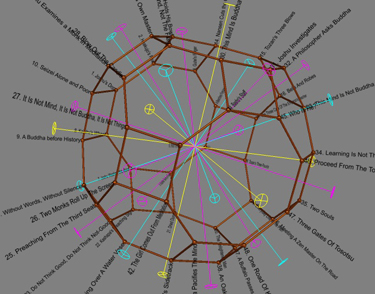 |
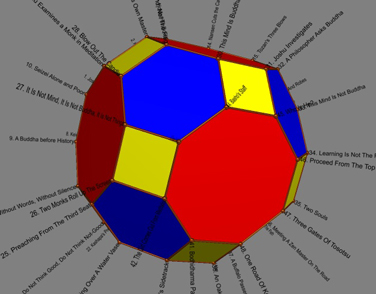 |
| Arbitrary mappings of 48 koan onto 48 edges of dual of rhombicuboctahedron (deltoidal icositetrahedron) (showing symmetry axes, reflection plane normals and reciprocation sphere) |
Partially unfolded truncated cuboctahedron above without arbitrary mappings of 48 koan onto vertices (showing symmetry axes) |
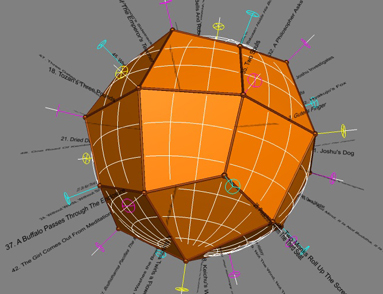 |
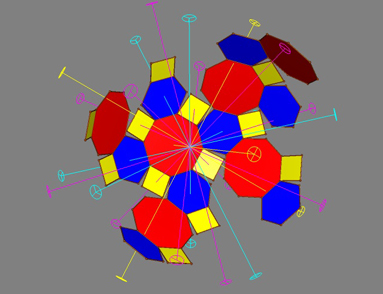 |
| Arbitrary mappings of 48 koan onto 48 edges of rhombicuboctahedron (showing reflection plane normals; with selected faces not visible) |
Arbitrary mappings of 48 koan onto 48 vertices of truncated cuboctahedron (showing symmetry axes; with selected faces not visible) |
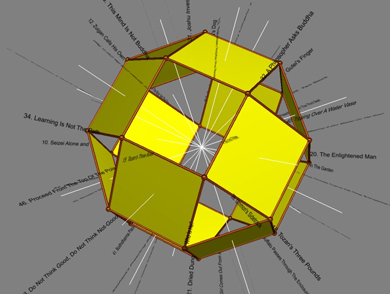 |
 |
***
| Arbitrary mappings of 48 koan onto 48 vertices of truncated cuboctahedron selected faces augmented with a pyramid |
|
| Projected outward | Projected inward |
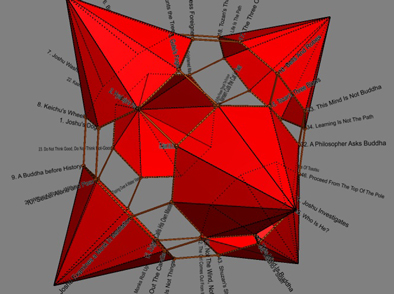 |
 |
***
| Simulating mapping into 4D | |
| Rhombicuboctahedron | Truncated cuboctahedron |
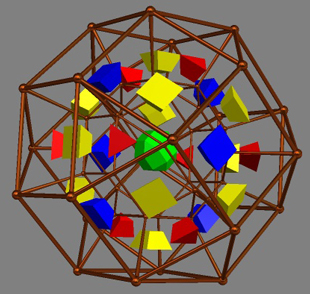 |
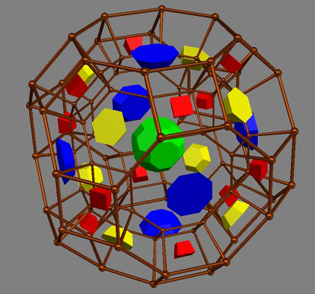 |
***
| Base / Dual Compounds derived from rhombicuboctahedron and truncated cuboctahedron |
|
 |
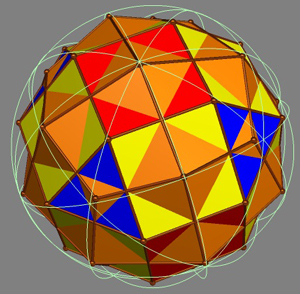 |
Conclusion
The above argument is further developed in what is effectively a second part to this paper (Enabling Wisdom Dynamically within Intertwined Tori: requisite resonance in global knowledge architecture, 2012). This has the following sections:
- Toroidal mappings of wisdom questions and answers
- Torus as a mapping surface
- Relating configurative mappings of 64 I Ching conditions and 48 koans
- Resonance as essential to both life and wisdom
- Embodying paradox
- Beyond fat tree global knowledge management
It is therefore more appropriate to locate the concluding arguments within that context, as with the complete set of references.
|
For further updates on this site, subscribe here |


